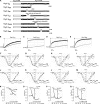Functional characterization of alternative splicing in the C terminus of L-type CaV1.3 channels
- PMID: 21998309
- PMCID: PMC3234967
- DOI: 10.1074/jbc.M111.265207
Functional characterization of alternative splicing in the C terminus of L-type CaV1.3 channels
Abstract
Ca(V)1.3 channels are unique among the high voltage-activated Ca(2+) channel family because they activate at the most negative potentials and display very rapid calcium-dependent inactivation. Both properties are of crucial importance in neurons of the suprachiasmatic nucleus and substantia nigra, where the influx of Ca(2+) ions at subthreshold membrane voltages supports pacemaking function. Previously, alternative splicing in the Ca(V)1.3 C terminus gives rise to a long (Ca(V)1.3(42)) and a short form (Ca(V)1.3(42A)), resulting in a pronounced activation at more negative voltages and faster inactivation in the latter. It was further shown that the C-terminal modulator in the Ca(V)1.3(42) isoforms modulates calmodulin binding to the IQ domain. Using splice variant-specific antibodies, we determined that protein localization of both splice variants in different brain regions were similar. Using the transcript-scanning method, we further identified alternative splicing at four loci in the C terminus of Ca(V)1.3 channels. Alternative splicing of exon 41 removes the IQ motif, resulting in a truncated Ca(V)1.3 protein with diminished inactivation. Splicing of exon 43 causes a frameshift and exhibits a robust inactivation of similar intensity to Ca(V)1.3(42A). Alternative splicing of exons 44 and 48 are in-frame, altering interaction of the distal modulator with the IQ domain and tapering inactivation slightly. Thus, alternative splicing in the C terminus of Ca(V)1.3 channels modulates its electrophysiological properties, which could in turn alter neuronal firing properties and functions.
Figures





Similar articles
-
Modulation of voltage- and Ca2+-dependent gating of CaV1.3 L-type calcium channels by alternative splicing of a C-terminal regulatory domain.J Biol Chem. 2008 Jul 25;283(30):20733-44. doi: 10.1074/jbc.M802254200. Epub 2008 May 15. J Biol Chem. 2008. PMID: 18482979 Free PMC article.
-
Functional properties of a newly identified C-terminal splice variant of Cav1.3 L-type Ca2+ channels.J Biol Chem. 2011 Dec 9;286(49):42736-42748. doi: 10.1074/jbc.M111.269951. Epub 2011 Oct 13. J Biol Chem. 2011. PMID: 21998310 Free PMC article.
-
Alternative splicing at C terminus of Ca(V)1.4 calcium channel modulates calcium-dependent inactivation, activation potential, and current density.J Biol Chem. 2012 Jan 6;287(2):832-47. doi: 10.1074/jbc.M111.268722. Epub 2011 Nov 8. J Biol Chem. 2012. PMID: 22069316 Free PMC article.
-
Functional diversity in neuronal voltage-gated calcium channels by alternative splicing of Ca(v)alpha1.Mol Neurobiol. 2002 Aug;26(1):21-44. doi: 10.1385/MN:26:1:021. Mol Neurobiol. 2002. PMID: 12392054 Review.
-
Neuronal calcium channels: splicing for optimal performance.Cell Calcium. 2007 Oct-Nov;42(4-5):409-17. doi: 10.1016/j.ceca.2007.04.003. Epub 2007 May 18. Cell Calcium. 2007. PMID: 17512586 Free PMC article. Review.
Cited by
-
Functional Effects of Schizophrenia-Linked Genetic Variants on Intrinsic Single-Neuron Excitability: A Modeling Study.Biol Psychiatry Cogn Neurosci Neuroimaging. 2016 Jan 1;1(1):49-59. doi: 10.1016/j.bpsc.2015.09.002. Biol Psychiatry Cogn Neurosci Neuroimaging. 2016. PMID: 26949748 Free PMC article.
-
Presynaptic Proteins and Their Roles in Visual Processing by the Retina.Annu Rev Vis Sci. 2024 Sep;10(1):347-375. doi: 10.1146/annurev-vision-101322-111204. Epub 2024 Sep 2. Annu Rev Vis Sci. 2024. PMID: 38621251 Review.
-
Calcium CaV1 channel subtype mRNA expression in Parkinson's disease examined by in situ hybridization.J Mol Neurosci. 2015 Mar;55(3):715-24. doi: 10.1007/s12031-014-0410-8. Epub 2014 Aug 31. J Mol Neurosci. 2015. PMID: 25173401
-
The Physiology, Pathology, and Pharmacology of Voltage-Gated Calcium Channels and Their Future Therapeutic Potential.Pharmacol Rev. 2015 Oct;67(4):821-70. doi: 10.1124/pr.114.009654. Pharmacol Rev. 2015. PMID: 26362469 Free PMC article. Review.
-
Germline de novo variant F747S extends the phenotypic spectrum of CACNA1D Ca2+ channelopathies.Hum Mol Genet. 2023 Feb 19;32(5):847-859. doi: 10.1093/hmg/ddac248. Hum Mol Genet. 2023. PMID: 36208199 Free PMC article.
References
Publication types
MeSH terms
Substances
Grants and funding
LinkOut - more resources
Full Text Sources
Molecular Biology Databases
Research Materials
Miscellaneous

